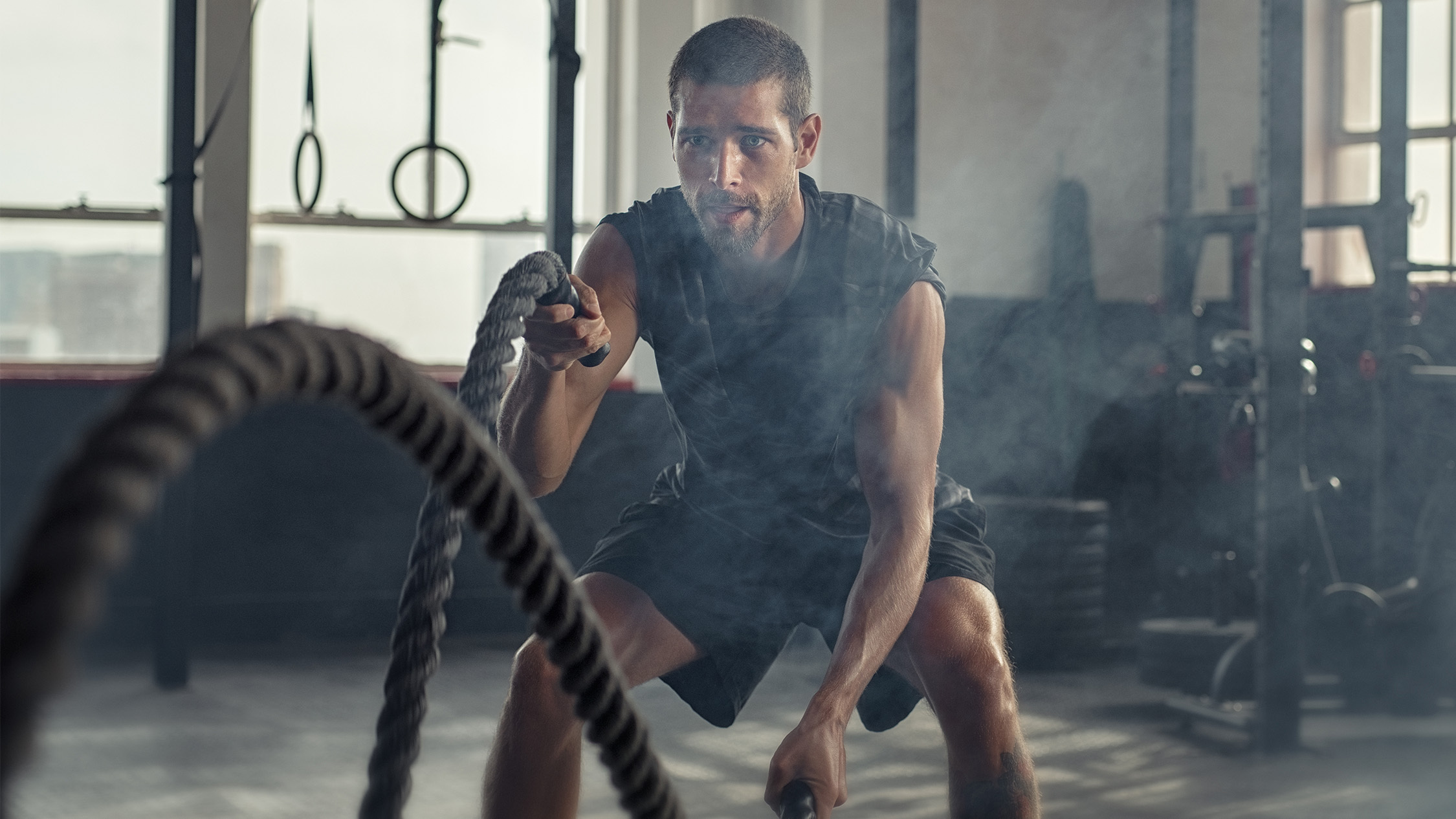
Battle ropes are a functional training exercise that can improve your strength and cardio fitness and build functional muscle by targeting most major muscle groups — like your shoulders and core muscles — and ramping up your heart rate. They're also guaranteed to kick up a world of pain.
A battle ropes workout forms part of many strength and conditioning programs because of the exercise’s versatility. It’s a metcon training tool, which combines strength, power, endurance, and aerobic exercise into one sweaty package to help the body improve how it uses energy. And in one study, eight weeks of battle rope training improved shooting accuracy, power, and core endurance in basketball players.
We spoke to Jesse Grund, pro wrestling strength and conditioning specialist, battle rope contributer to Living.Fit and owner of Unconventional Strength, who provided this belter of a battle rope workout to get you gassed and challenge your fitness levels — without the gym or heavy weights.
Benefits of battle rope
The benefits of battle ropes are endless, according to Grund. “Battle ropes won’t get you sore because of how they utilize muscle contractions,” Grund says. “You could train with a battle rope every day. They also allow for freedom of movement which is important for learning how to create force and strength in various positions, much like life throws at us, which makes it truly functional training.”
Grund adds that battle ropes are infinitely adaptable. “As you progress with a battle rope, just taking a few steps toward the anchor point creates a new set of challenges.” If it's a 50-foot rope (which Grund recommends), that's 50 feet of challenges fully lengthened and 25 feet of new challenges if you double up the rope and hold it in both hands.
Moreover, It can create a stimulus for multiple systems of energy. Grund explains that you can build aerobic efficiency, anaerobic endurance, strength, and power all over using one tool. Talk about bang for your buck.
Battle Rope Workout to Try
“This workout was taken from the "Battle Rope Origins" program on Living.Fit,” Grund explains. “Start with a dynamic warm-up and stretching routine for five minutes, then move into the four-move workout below.”
Get instant access to breaking news, the hottest reviews, great deals and helpful tips.
If you’re short on warm-up ideas, I recommend Obi Vincent’s hip mobility exercises and some light upper-body cardio. You could perform this battle rope workout as a circuit, moving through each exercise one set at a time, or complete one exercise followed by the next. Cool down afterward with some stretching and breathing exercises. I recommend Chris Hemsworth’s breathing exercise and this one move for hip flexor pain.
1. Battle rope double vertical waves
5 SETS | 30 Seconds WORK | 00:30 REST
During the double vertical waves (moving both arms together), try to avoid creating too much tension in the ropes. Take a step or two forward and relax your grip to free up the move. Stand tall and engage your abs which should give you room to move. Aim for waves rather than slamming the battle ropes, keeping moves fluid and consistent. This is a real shoulder torcher!
2. Battle rope double lateral waves
5 SETS | 30 Seconds WORK | 00:30 REST
It’s a simple move with the battle ropes, working the body in the transverse and frontal plane, meaning your body is rotating and shifting from right to left to gain a strong and stable platform. Feet should be hip-width apart or slightly wider, and drop your hips for stability. Rotate the torso and “push the waves laterally.” The team advises the faster you rotate, the more your abs, upper back, shoulders, biceps, triceps, and grip will engage. By stepping forward, you’ll create more force and engagement.
3. Battle rope double outside circles
5 SETS | 30 Seconds WORK | 00:30 REST
The Living.Fit team advises using this battle rope exercise to create strong, stable, and supple shoulders – improving their ability to move freely. Create big circles or start small and slowly increase. You’re looking for rhythmic “cyclonic” movements rather than vertical or lateral, which work your shoulders in an entirely different plane of motion.
4. Battle rope double alternating waves
5 SETS | 30 Seconds WORK | 00:30 REST
It’s considered the “OG” of battle rope movements. The team advises you to keep enough slack on the ropes to move in vertical waves and alternate them. Focus on keeping your shoulders down, chest proud, and abs engaged. Avoid hyper-hinging or gripping too tight. Stand tall and maintain a soft bend in your hips and knees as you move.
Battle rope workout: verdict
The battle ropes will dynamically challenge your grip strength and shoulder stability, building dynamic crossbody connection and stability. For example, the alternating wave is the "bread and butter" of battle rope movements, according to Grund.
“Alternating waves create force via the sling system of the body (muscle connecting one side of the body to the other) and, in turn, produce force much like we sprint and move,” he says. “Battle ropes challenge body stability, which is a necessary component in most training programs and basic human function.”
Battle ropes are easy to find. If you’re considering buying one, Grund recommends a 50-foot, 1.5-inch battle rope and nylon loop. You can attach the loop to a tree, pole, or heavy object like a kettlebell and create a double or single rope.
Next: Build upper-body strength with the best dumbbell chest workouts, and for more functional workout ideas, I did 50 wall balls every day.

Sam Hopes is a level 3 qualified trainer, a level 2 Reiki practitioner and fitness editor at Tom's Guide. She is also currently undertaking her Yoga For Athletes training course.
Sam has written for various fitness brands and websites over the years and has experience across brands at Future, such as Live Science, Fit&Well, Coach, and T3.
Having coached at fitness studios like F45 and Virgin Active and personal trained, Sam now primarily teaches outdoor bootcamps, bodyweight, calisthenics and kettlebells.
She also coaches mobility and flexibility classes several times a week and believes that true strength comes from a holistic approach to training your body.
Sam has completed two mixed doubles Hyrox competitions in London and the Netherlands and finished her first doubles attempt in 1:11.




